The Best Places to Eat and Drink in Mexico City, According to Our Readers
For Mexico City-born Ximena N. Beltran Quan Kiu, it’s no surprise Food & Wine readers voted it the world’s best city for food.

Sergio Mendoza Hochmann / Getty Images
Global Tastemakers is our first-ever reader’s choice awards, celebrating the best culinary destinations in the U.S. and abroad. F&W readers voted based on travel completed within the past three years, on categories including restaurants and bars, cities, hotels, airports, airlines, and cruises. Due to the limitations of pandemic travel, this year’s Global Tastemakers winners reflect a smaller portion of the globe. In many categories, we’re including an editor’s pick to shout out some more culinary destinations in places you can’t miss. See the full list of winners at foodandwine.com/globaltastemakers.
There is a famous mariachi song by singer Luis Miguel titled México en la Piel, “Mexico in your skin,” that Mexicans go wild for. In the 2004 song, he sings: “Como el buen tequila de esta tierra/ O la artesanía en San Miguel/ Como contemplar el mar Caribe. Así se siente México.” Translated, the lyrics mean “Like a great tequila from this land/ Or the handcrafted work in San Miguel/ Like contemplating the Caribbean sea. This is how Mexico feels." While the song is an homage to all of Mexico, the country’s charm converges in Mexico City.
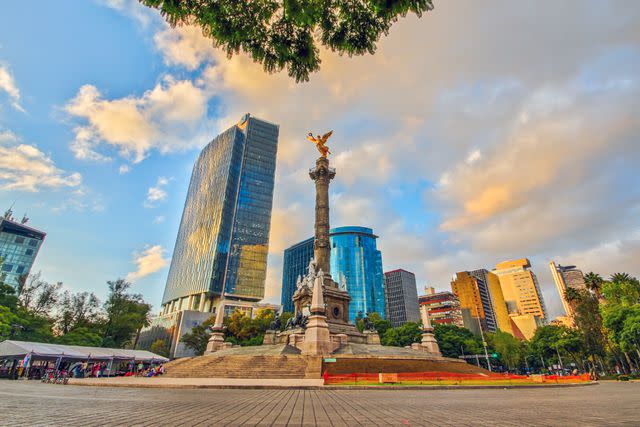
Sergio Mendoza Hochmann / Getty Images
I’ve always wished people could see and taste Mexico City, my hometown, the way I experience it, and now it feels like they finally are. Even now, whenever I go home, I plan my days around what I will eat. Long before I had the budget to eat in its fancier restaurants, I developed my love for Mexican food en los puestos, street food stalls. Esquites, tamales Oaxaqueños, quesadillas con flor de calabaza, tlayudas made with masa azul, and of course, tacos with homemade salsa, were all washed down through a rotation of aguas frescas like jamaica, guayaba and sandia.
It’s in its food that I learned the tale of Mexico’s natural riches and complex history. Its street vendors carry ancestral knowledge, passed down from multiple generations that allow them to not only craft some of the best tacos, stews, and desserts but to preserve Mexican culture. This knowledge and pride in Mexican ingredients and techniques have inspired a new generation of chefs to showcase Mexican food in the same arena as other cultures that are already synonymous with fine dining.
Mexico City and its food is having a moment. But make no mistake — it’s always been the best for those in the know. When I think of where I come from, I also think of my family. My 21-year-old cousin has never been on a plane; he dreams of visiting Paris. I hope he does, but I also hope he sees the beauty of where he comes from. Right now, there are people from all over the world planning a trip to Mexico City to experience something he has access to every day. And when they come, Miguel’s infamous words: “This how Mexico feels/ This is how Mexico tastes/ This is how you carry Mexico in your skin,” will make sense to them.
These are the bars and restaurants from Mexico City that Food & Wine readers voted the best in the world.
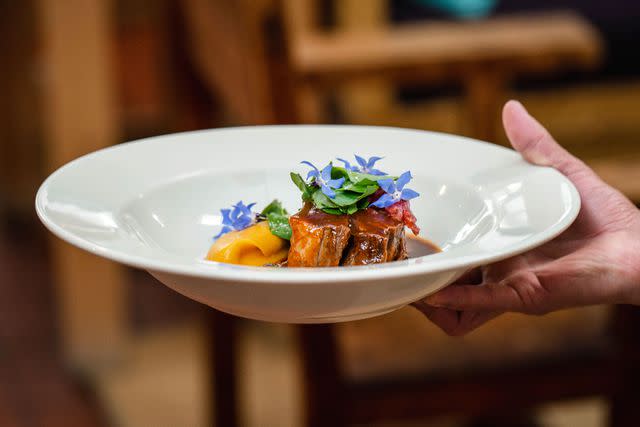
Alejandro Yanes
Maximo Bistrot
People come to this Roma Norte restaurant for the food — an ambitious menu that changes daily and features seasonal ingredients found across Mexico. But it’s also very pretty: Maximo Bistro is an Instagram favorite, with its natural lighting and plenty of green foliage. The restaurant serves a combination of Mexican dishes featuring regional ingredients – like the aguachile made with Pacific scallops, a sincronizada (quesadilla-style) meal stuffed with birria marinated for half a day, and a crab in mole verde “tlayuda” – alongside pasta dishes like tagliatelle served in a beef tail and duck sausage ragù and Japanese Wagyu. The stunning interior somehow manages to feel as if you’re dining outdoors, with its upscale, rustic vibe that is reminiscent of haciendas in the Mexican countryside. It’s clear that chef and owner Eduardo García takes his work seriously. The Mexico-born Chef raised in the U.S. rose from migrant worker, convicted felon, and deportee to become one of the country’s most formidable chefs. He came up under Enrique Olvera, owner of Pujol, the Mexican restaurant that started the country’s culinary revolution. García’s passion for championing Mexican culture shines through in every detail of this dreamy restaurant.
Azul Condesa
What started off as a cafeteria in Mexico City’s famous National Autonomous University of Mexico (UNAM campus) is now a homey restaurant highlighting local and regional flavors. The restaurant prides itself on the promotion of culinary cuisines from the country’s pre-Colombian past. The menu is anchored in traditional items such as guacamole, tacos de lechón, and tamales. There’s a supplementary menu that rotates every month to feature ingredients, dishes, and cooking techniques from Mexico’s 31 states. Take, for instance, el pescado tikin xic, the seafood version of the pork-based cochinita pibil—a fish marinated in adobo de achiote and sour oranges, wrapped in banana leaf and cooked in a wood fire oven, originates from the Yucatán Peninsula. The service is exemplary. The staff is friendly and attentive without being overbearing. With high ceilings, natural light, and beautiful decor every way you turn, the two-story restaurant is perfect for lunch or dinner.
Licoreria Limantour
There’s no better place to post up, enjoy the day (or night), and people watch than at the city’s go-to cocktail destination in the Roma neighborhood. The bar may be more than a decade old, but it continues to delight guests with a menu that rotates every six months, while keeping mainstays like their Mexican old-fashioned (a whisky-based cocktail, fat-washed with cacao and nutmeg) on the menu. Its seasonal menu features inventive cocktails using local ingredients like the whiskey-based, lobster mushroom drink with butter. Trust the friendly and knowledgeable staff to help find the perfect cocktail. Visit for a drink before bopping over to any one of the popular dining spots located within walking distance, or stay for a few and work your way through the menu. The two-story bar is the perfect place to see and be seen.
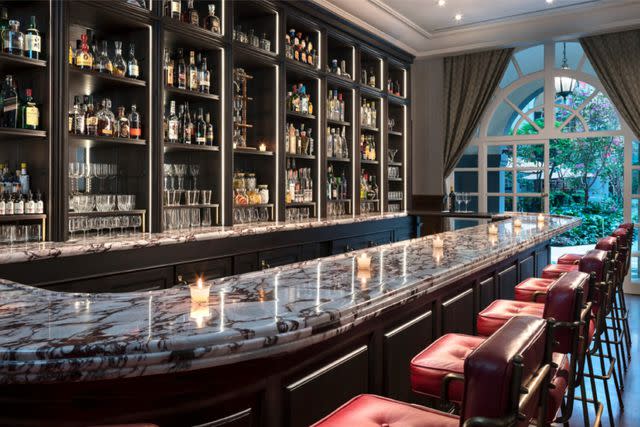
Courtesy of Fifty Mills
Fifty Mils
One of the biggest selling points of the upscale bar located within the Four Seasons Mexico City is that it’s tucked away from the hustle and bustle of the city. Located adjacent to a courtyard filled with green foliage, blooming flowers, and a gigantic fire pit, guests have the option of sipping their drinks either indoors or outdoors. The bar’s most popular drink is the Pink Huichole, a tequila-based watermelon cocktail, named after the native people of Mexico’s southwest coast. Mosh Blanco, the mixologist at Fifty Mils, says the drink embodies two of the city’s cultural influences. “Diego [Rivera] and Frida [Kahlo] both used watermelon as a way to symbolize eroticism. Watermelons also represent Mexico’s colors of red, green, and white. It’s a drink that is symbolic of the country and its culture — despite originating in Africa.” Whether you order the sweet drink or another, the bar is a tranquil and luxurious oasis in the middle of the biggest city in North America.
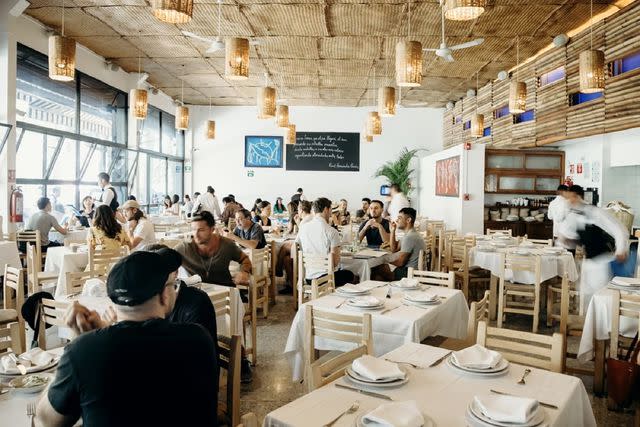
Courtesy of Contramar
Contramar
Chef Gabriela Cámara’s restaurant is a seafood lover’s dream. Sole is served up in a green salsa alongside slivers of cactus; instead of meatballs made of beef or pork, Cámara makes hers with fish; the grilled octopus comes in a chile meco marinade (and is also prepared as a taco, salad, and sope). The restaurant is known for its fresh ingredients, and it’s no wonder that it continues to be one of the city’s top dining locations. Diners can choose between indoor or outdoor seating (even if you’re inside, the glass floor-to-ceiling windows provide a clear view of the outside world). The decor is simple, elegant, and breezy with an upscale feel that somehow manages to avoid feeling stuffy. Make a reservation in advance. The dining room fills up quickly and walk-ins will have a hard time getting seated.
Pujol
The restaurant most cited for launching the Mexican culinary revolution is Enrique Olvera’s Pujol. Located in the posh Polanco neighborhood of the city, the 75-seater restaurant tells the story of Mexico’s history through native ingredients, all presented in an upscale and high-end dining experience. Oliveria brings street food staples like esquites, corn kernels boiled with the epazote herb, to fine dining. Pujol’s seven-course tasting menu features snail ceviche in cilantro oil, chicatana ants in mayo sauce, and a standalone mole sauce (served with only tortillas — an uncommon practice and true rarity) that’s been aged for 2,500 days. When it opened in 2000, Pujol ignited a culinary movement that spilled over Mexico’s borders into the U.S. More than 20 years later, it continues to propel the city’s dining scene forward and attract diners near and far, while also inspiring a new generation of chefs across the world.
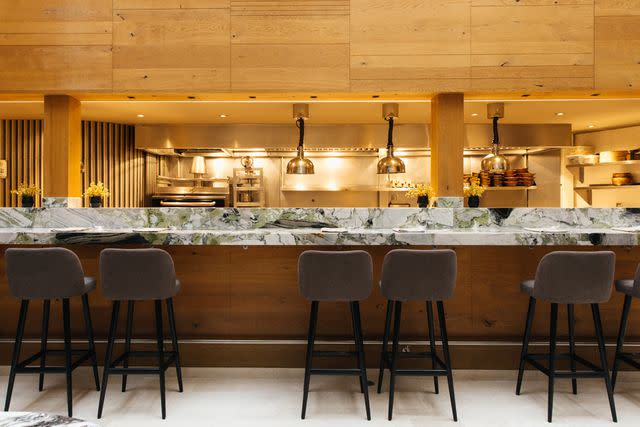
Courtesy of Quintonil
Quintonil
Jorge Vallejo and Alejandra Flores are the wife-and-husband duo behind one of the city’s most iconic eateries. Chef Vallejo tends to the back of the house, while Flores tackles the front of house operation. The two met, fell in love, and began dating while working at Pujol, Enrique Olvera’s revolutionary restaurant. They live by the motto, “He who does not live to serve, does not serve to live.” Vallejo’s menu is rooted in his Mexican culture, largely shaped by his grandmother’s cooking and use of local ingredients. Diners have the option to choose between a tasting menu or can order à la carte. Spider crab in pipián verde (green mole sauce) served with blue corn tostadas, a charred avocado topped with escamoles (edible larvae of ants), and cactus paddle sorbet are among its most-loved offerings. The restaurant recently received a facelift and added counter seating to its warm, brightly lit dining room.
For more Food & Wine news, make sure to sign up for our newsletter!
Read the original article on Food & Wine.

